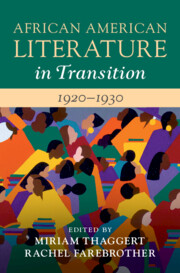Book contents
- African American Literature in Transition, 1920–1930
- African American Literature in Transition
- African American Literature in Transition, 1920–1930
- Copyright page
- Contents
- Illustrations
- Contributors
- Acknowledgments
- Chronology of Historical Events, People, and Publications, 1920–1930
- Preface
- Introduction
- Part I Habitus, Sound, Fashion
- Part II Space
- Part III Uplift Renewed
- Part IV Serial Reading
- Chapter 11 The Midnight Motion Picture Company Goes to Europe
- Chapter 12 African American Magazine Modernism
- Bibliography
- Index
Chapter 12 - African American Magazine Modernism
from Part IV - Serial Reading
Published online by Cambridge University Press: 17 March 2022
- African American Literature in Transition, 1920–1930
- African American Literature in Transition
- African American Literature in Transition, 1920–1930
- Copyright page
- Contents
- Illustrations
- Contributors
- Acknowledgments
- Chronology of Historical Events, People, and Publications, 1920–1930
- Preface
- Introduction
- Part I Habitus, Sound, Fashion
- Part II Space
- Part III Uplift Renewed
- Part IV Serial Reading
- Chapter 11 The Midnight Motion Picture Company Goes to Europe
- Chapter 12 African American Magazine Modernism
- Bibliography
- Index
Summary
Young’s “African American Magazine Modernism” argues that it is important to recognize the extent to which African American writers and artists appeared in a wide range of magazines in the 1920s. This chapter examines moments of cross-cultural interaction, including such examples as the pieces of Jean Toomer’s Cane distributed across race-conscious, avant-garde, and regional magazines (1922-23); Zora Neale Hurston’s “How It Feels to Be Colored Me” in the pacifist-socialist journal The World Tomorrow (1928); and the infamous case of Nella Larsen’s “Sanctuary” in Century Magazine (1930). Reading African American modernism across these disparate bibliographical environments yields not an easily coherent picture but what John Bryant terms the “muddy materiality” of textual history.
Keywords
- Type
- Chapter
- Information
- African American Literature in Transition, 1920–1930 , pp. 310 - 334Publisher: Cambridge University PressPrint publication year: 2022

